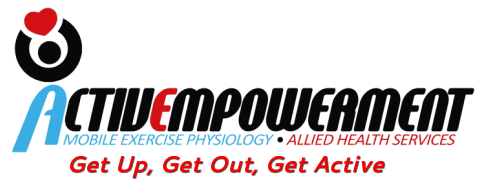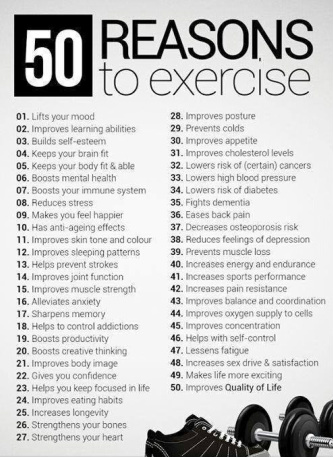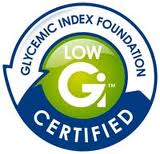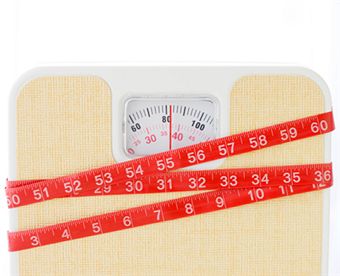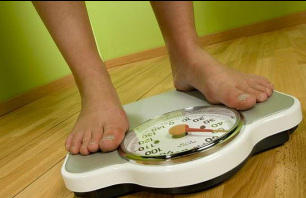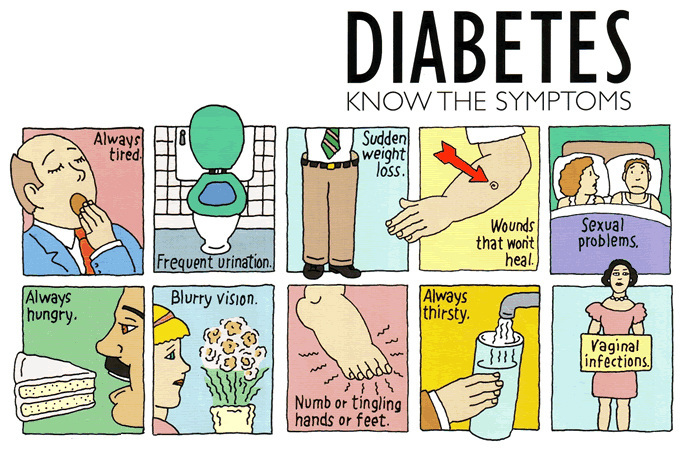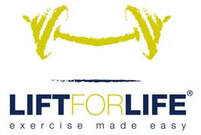Health Tip 1 - MotivationBeing motivated to exercise is always the hardest obstacle to overcome. It sounds simple - but try planning a monthly diary with at least 2-3 scheduled exercise sessions per week. Make a promise to keep to your scheduled exercise session just like you would for any other event, such as a planned dinner with friends or an office meeting.
Start small and build up from there. This may mean increasing the intensity of exercise, increasing the frequency of sessions, or the length of each session over time. For some, establishing a routine might start with 10-20 minutes of walking every 2-3 days. At Activempowerment, we are able to assist people who are looking to start an exercise regime and we also have exercise and nutrition diaries available on request. Please contact us to find out more. For those who already have an established routine, try mixing it up and doing something different. The body enjoys novel movements. So if you feel stale, give a new sport, exercise or outdoor activity a go. |
Health Tip 2 - Gylcaemic Index (GI) & Low GI FoodsThe Glycaemic Index (GI) ranks carbohydrate containing foods according to their effect on blood glucose(sugar) levels. This is a particularly important tool for people suffering from diabetes or looking to choose healthy carbohydrate options.
Foods with a high GI are digested and absorbed quickly causing a rapid rise in blood glucose levels. Foods with a low GI are digested and absorbed slowly, producing smaller rises in blood glucose. So, in plain language, low GI foods keep you fuller for longer and help to prevent you from snacking on unhealthy items to alleviate hunger. Low GI foods include wholegrain and high fibre breads and cereals, long grain as opposed to medium grain rice, noodles, most fruits except watermelon, most vegetables except potato and other starchy vegetables and all dairy products (preferably low fat). Low GI, packaged food items often have the GI symbol or 'low GI' visible on their packaging. Prolonged high blood glucose can lead to long term diabetic complications. Some complications include kidney damage, increased risk of heart disease, numbness and tingling in feet, decreased wound healing and, in extreme cases, amputation. Following a low GI diet can help you control diabetes and prevent long term complications, decrease your risk of developing diabetes, heart disease and some cancers, decrease your cholesterol levels and help you to lose and manage your weight. In summary, simple items you can change to make your diet low in glycaemic index include: - Switching from a white bread to a wholegrain or wholemeal bread. - Replacing high sugar commercial breakfast cereals e.g. coco pops, rice bubbles with high fibre options e.g. untoasted muesli, bran or high fibre weetbix. - Choosing a long grain rice like basmati or noodles instead of a medium grain rice like Jasmine rice. |
Health Tip 3 - How Do You Measure Up?When concerned about body fat, most people are quick to jump on the scales to see their weight. After being disappointed, a week of ‘no carbs’ and maybe completing one bout of exercise its time to jump on the scales again… and there may perhaps be a loss of 1-3 kilos, but how accurate is this measurement? When we weigh ourselves on scales, what is added up is the combined weight of our body water, muscle, bone, organs, tissues, food eaten and body fat. Small fluctuations (both up and down) could be due to the amount of water consumed, how much food has been eaten or perhaps recent bathroom patterns.
This does not mean don’t weigh yourself at all. Just weigh smarter, aiming for continuous weight loss or gain over many weeks. Weigh yourself under the same circumstances each week (e.g. at 8am each Monday morning before breakfast and after going to the bathroom). Also it is a very good idea and perhaps better practice to measure your waist circumference if you are looking at losing body fat. Other ways to measure your body fat are through underwater weighing, skin fold measurements or bioelectrical impedance analysis (however these three methods require special equipment and/or a trained professional). For information on strategies to monitor and maintain your desired weight |
Health Tip 4 - The Best Way To Lose Body FatWe are often asked what is the best way to lose fat. Our answer is simple but we are often met with a confused "is that the only advice you can give me" looking face.
The simple answer......... RUNNING! And you know what? If you can't run, then move more and put less in your mouth! The more muscles recruited to perform movement, the greater amount of energy (kilojoules/calories) you will burn. Studies have shown that running is the most effective way to use up readily available energy (carbohydrates in the muscles) and stored energy (fat). If you can't run, don't like running or find it boring; refer back to our answer "move more". Pick an exercise that you enjoy: cycling, swimming, sports, boxing, tennis, personal training... the list goes on. Despite all the marketing and celebrity endorsements for rapid weight-loss schemes (fad exercise crazes, fancy abdominal crunches, shakes, pills, no-carb diets), these alone are not effective or sustainable methods to lose and maintain healthy weight. What they are good for however, is reducing the waist line of your bank balance. There is no magic pill to a healthy body - you need to do the hard work! It is however, possible to enjoy your exercise and make it a part of your routine! Activempowerment are here to help guide you contact us to make an enquiry. |
|
Health Tip 5 -Learning to Recognise the Signs of Diabetes
There's no doubt that people keep hearing about the term 'diabetes', and how the condition is on the rise.
Diabetes is a challenging problem for public health organisations worldwide, resulting in substantial morbidity and mortality rates. It is associated with a myriad of complications, particularly those resulting in cardiovascular complications, diseases of the eye and kidney, and limb amputations. While the condition is not curable per se, methods associated with lifelong management are available.
Millions of cases are left undiagnosed every day due to the simple fact that people aren't aware of what signs to look out for. Learning to recognise the symptoms of the disease is a crucial part in understanding how to manage the condition.
Before we educate on what symptoms to look out for, it's best to understand the condition first.
So, what exactly is Diabetes?
Diabetes is a condition where your blood glucose (blood sugar) is too high. The human body requires this sugar as a form of energy to drive our energy levels, therefore there will always be glucose present in our bloodstream. Too much glucose in the blood however, can lead to complications.
- Type 1 or Type 2?
- What's the difference between the two?
- How does one know if they are a diabetic?
Diabetes is a challenging problem for public health organisations worldwide, resulting in substantial morbidity and mortality rates. It is associated with a myriad of complications, particularly those resulting in cardiovascular complications, diseases of the eye and kidney, and limb amputations. While the condition is not curable per se, methods associated with lifelong management are available.
Millions of cases are left undiagnosed every day due to the simple fact that people aren't aware of what signs to look out for. Learning to recognise the symptoms of the disease is a crucial part in understanding how to manage the condition.
Before we educate on what symptoms to look out for, it's best to understand the condition first.
So, what exactly is Diabetes?
Diabetes is a condition where your blood glucose (blood sugar) is too high. The human body requires this sugar as a form of energy to drive our energy levels, therefore there will always be glucose present in our bloodstream. Too much glucose in the blood however, can lead to complications.
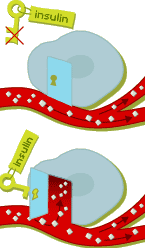
Normally, insulin acts as a signal to promote glucose uptake and metabolism in the muscle. You may find it easier to understand when you think of the insulin being a key, and the muscle being the lock.
In diabetics though, this signal is disrupted. Either the pancreas isn't able to produce insulin to trigger this signal (type 1 diabetes), or the muscle is resistant to it (type 2 diabetes).
Referring back to the key and lock analogy - without the key (insulin) acting as the signal, the lock (muscle) cannot be unlocked. Therefore, the sugars in the blood cannot be used as a form of energy in the muscle. The sugars get trapped in the bloodstream, resulting in elevated blood glucose readings.
In diabetics though, this signal is disrupted. Either the pancreas isn't able to produce insulin to trigger this signal (type 1 diabetes), or the muscle is resistant to it (type 2 diabetes).
Referring back to the key and lock analogy - without the key (insulin) acting as the signal, the lock (muscle) cannot be unlocked. Therefore, the sugars in the blood cannot be used as a form of energy in the muscle. The sugars get trapped in the bloodstream, resulting in elevated blood glucose readings.
Type 1 vs. Type 2 Diabetes
Type 1 Diabetes (T1D)
Type 2 Diabetes (T2D)
* Note: The prevalence of diabetes in much younger individuals is drastically on the rise.
Type 1 Diabetes (T1D)
- Autoimmune disease.
- Due to insulin deficiency.
- Caused by the destruction of pancreatic cells which produce insulin, leading to an impaired ability to produce insulin.
- Can be triggered by many factors, such as: genetics, malnutrition, and the environment (e.g. viruses).
Type 2 Diabetes (T2D)
- 'Lifestyle disease'.
- Due to insulin resistance.
- The body is capable of producing insulin, but it cannot be used effectively, as the body fails to respond to the signals sent by the brain.
- Common in older people, obese individuals, and those with a family history of diabetes or gestational diabetes.*
* Note: The prevalence of diabetes in much younger individuals is drastically on the rise.
Symptoms to be aware of include the following:
Many of these symptoms may be indicative of other conditions as well, but it is always important to get yourself checked over by a doctor. If you notice any of the symptoms listed above arrange to see your GP as quickly as possible.
Activempowerment run group exercise classes that are targeted at individuals with Diabetes. Contact us to find out more.
- Constantly feeling thirsty
- Unexplained fatigue
- Unexplained weight loss
- Frequently going to the toilet
- Having blurred vision
- Muscle wastage
- Itching around the genital areas
- Frequent bouts of thrush
- Getting infections on a regular basis
Many of these symptoms may be indicative of other conditions as well, but it is always important to get yourself checked over by a doctor. If you notice any of the symptoms listed above arrange to see your GP as quickly as possible.
Activempowerment run group exercise classes that are targeted at individuals with Diabetes. Contact us to find out more.
Health Tip 6 - Prehabilitation
Are you about to undergo surgery? You may have heard of rehabilitation, but have you ever considered rehab prior to surgery, or PREhab? Numerous scientific studies have shown the benefits of rehabilitation prior to common surgeries such as total knee and hip replacements. Benefits include shorter recovery time, reduced hospital stay and better functional outcomes post-surgery. With specific reference to total hip replacement, 3 separate studies conducted by Larsen, Hansen and Soballe et al, showed an average reduction in length of hospital stay of 3.1 days, and found significant improvements in health-related quality-of- life scores.
The idea behind prehab, with particular regard to orthopaedic surgeries, is to strengthen the muscles and improve your cardiovascular reserve prior to surgery. The theory is that the greater this initial reserve, ie your health and fitness, the lesser the impact of the surgery. Usually, weight bearing restrictions are put in place following surgeries such as spinal fusion, total knee and hipreplacements. Periods of reduced weight bearing combined with limited activity can lead to severe de-conditioning, making it even more of an uphill battle post-surgery. Prehabilitation aims to send you into surgery in the best possible shape with the aim of reducing post-operative complications and easing the burden of post-operative rehab.
If you are awaiting surgery, it may be time to contact one of our specialist Exercise Physiologists at Activempowerment to discuss specific options for you regarding prehabilitation. Our Exercise Physiologists will tailor a program to suit your needs as well as providing education on what to expect post-surgery.
The idea behind prehab, with particular regard to orthopaedic surgeries, is to strengthen the muscles and improve your cardiovascular reserve prior to surgery. The theory is that the greater this initial reserve, ie your health and fitness, the lesser the impact of the surgery. Usually, weight bearing restrictions are put in place following surgeries such as spinal fusion, total knee and hipreplacements. Periods of reduced weight bearing combined with limited activity can lead to severe de-conditioning, making it even more of an uphill battle post-surgery. Prehabilitation aims to send you into surgery in the best possible shape with the aim of reducing post-operative complications and easing the burden of post-operative rehab.
If you are awaiting surgery, it may be time to contact one of our specialist Exercise Physiologists at Activempowerment to discuss specific options for you regarding prehabilitation. Our Exercise Physiologists will tailor a program to suit your needs as well as providing education on what to expect post-surgery.
